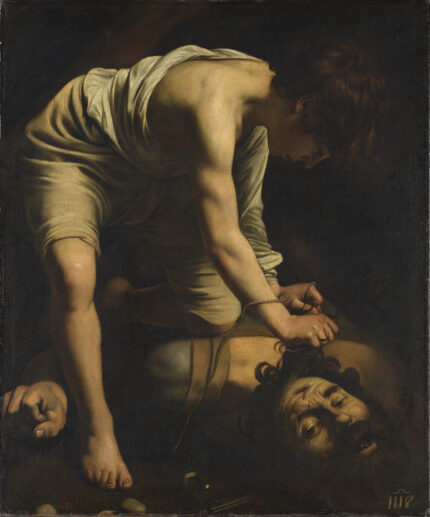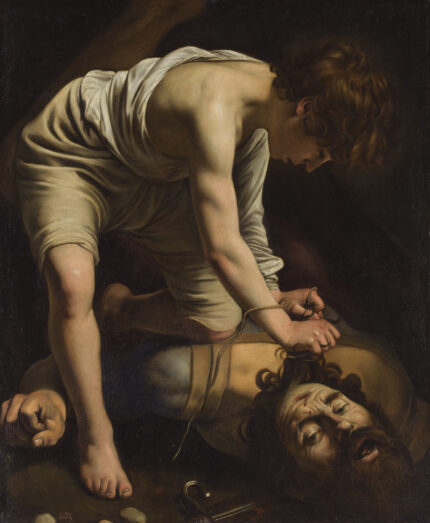
 David with the Head of Goliath in the Prado Museum, the only work by the Baroque master Caravaggio in Madrid and one of only four in all of Spain, has been restored, revealing its original colors, tones and compositional elements that were hidden under years of dirt and yellowed varnish.
David with the Head of Goliath in the Prado Museum, the only work by the Baroque master Caravaggio in Madrid and one of only four in all of Spain, has been restored, revealing its original colors, tones and compositional elements that were hidden under years of dirt and yellowed varnish.
Created around 1600 when Caravaggio had just burst on the scene in Rome causing a sensation with his intense contrasts of light and dark and embrace of naturalism, this version of the Biblical story of the boy David’s triumph over the Philistine giant Goliath depicts David reaching to grab Goliath’s head, which he has just severed, by the hair to string it up with a rope. This was a radical new perspective for a story that had been so often painted before, and it would exert a powerful influence on artists who followed him.
It entered the Royal Collection in Madrid in 1794 and has been on display continuously since. Last year it was part of a Guido Reni exhibition and its dire need of conservation was so evident it caused comment. In September of this year, restorer Almudena Sánchez began the treatment process.
The principal aim of this restoration has been to reinstate the original image devised by Michelangelo Merisi, “il Caravaggio”, which had been disappearing over time beneath layers of dirt and oxidised varnish. The opaque nature of these old layers of varnish eliminated the space and depth in the composition. This made it more difficult to perceive the dimensions of the place in which David and Goliath are located, given that within the scene as a whole it was only possible to distinguish the parts of the figures brightly illuminated by the focused light source.
This issue was also partly the result of previous selective cleanings, which had essentially concentrated on the foreground planes and the most brightly lit parts of both figures, ignoring the background of the composition and the areas in shadow. The result was to gradually transform Caravaggio’s original chiaroscuro into a violent contrast of light and dark, leaving the figure of David outlined against a flat black background. The composition was consequently reduced to a single plane.
The yellowish tone of the old varnish altered Caravaggio’s original colours, giving a warmth to the pale, luminous tones of the flesh and clothing which totally modified the artist’s concept. In turn, the loss of transparency in the varnish blurred the volumes and eliminated the elements located in the background and in the areas of shadow. In these conditions it was only possible to appreciate the scene depicted by Caravaggio in a partial manner.
The restoration of the depth of field revealed significant areas of the complex composition previously lost to the darkness, including Goliath’s buttock on the right, his bent leg rising off the canvas behind David’s back. A previously invisible pale round of light around David’s head has also been uncovered.
X-rays revealed that Caravaggio had made a major change in composition: Goliath’s head was first captured still living, eyes wide, mouth open in a yell. Caravaggio changed that in the final version, half-closing his vacant eyes and making the opening of the mouth smaller so you can’t see his upper teeth and tongue.
According to Almudena Sánchez, the restorer who has undertaken the project: “This restoration reveals a new Caravaggio, giving us a previously unknown image of the painting, the true image of this great masterpiece which after so long in the shadow has recovered the light with which it was originally conceived.”
“the only work by the Baroque master Caravaggio in Madrid and one of only four in all of Spain”.
Actually, 3 of 4 are in Madrid.
This David (Prado), St.Catherine (Thyssen-Bornemisza) and eventually Salome (Colecciones Reales – Patrimonio Nacional).